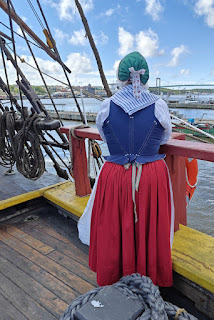This outfit was made for a visit to Götheborg of Sweden, the world's only replica of an 18th century Ostindia ship. It was built 20 years ago, as a copy of a ship that sank outside Gothenburg in 1745.
I had for some reason never been to see the ship, and I thought that it would be nice to dress up for it. My folk costume is late 18th-early 19th century in style, so that wouldn't work - I had to make something new. The entire outfit is hand sewn.
However, since folk costumes are based on popular clothing I used preserved garments from the middle of the 18th century as one of the sources for this outfit.
Bodice
The bodice, which is made from a wool outer layer and linen lining was inspired by preserved folk costume bodices from the middle of the 18th century, such as this one.
Shift
The shift, which I will use for my folk costume too, is based on a preserved shift from Nationalmuseet in Copenhagen, Denmark. it is dated to 1775, which is a bit too late for this costume, but just right for my folk costume. I went with it anyway, because it is from Scandinavia, and because shiofts and other underwear tend to be conservative in cut. The pattern can be found in the book "Moden i 1700-årene" by Ellen Andersen.
Skirt
For the skirt I used my folk costume skirt, which is made from a half linen/half wool hand woven fabric.
Apron
The apron is a simple white linen one, which was easy to wash - and bleach! By this time clean linens had become an important sign of cleanliness in Europe (see for example John Styles' amazing book. "The Dress of the People: Everyday Fashion in 18th century England). Since the 17th century aprons had also become a fashion accessory, and they were often white.
Printed cottons were becoming part of popular fashion in for example England and the Netherelands, but in the 1740s they were extremely rare in Sweden. Also when looking at 1740s art from Europe white, or plain coloured, aprons appear to have been the most common.
I used the same construction for this apron as for the ones that I use for my folk costume, since it is decribed as an 18th century construction on the Nordiska Museet web site (link to the original for my folk costume apron)
Kerchief
The kerchief is a striped linen square. Striped kerchiefs are common in the 18th century rural probate inventories that I have studied.
Cap
In depictions of working class women, both Swedish and from the rest of Europe a combination of an under cap from linen with a coloured cap over it is very common.
I actually made three of each for this costume, changing the pattern slightly between them. I guess i got a bit carried away.
The pattern is made from looking at several 18th century caps in the collections of Nordiska Museet.
This one is from Finland:
And these are from Sweden. All of these pictured are from the first half or middle of the 18th century.
Later on in the 18th, and early 19th, century these caps would be transformed to the hard "bindmössa" of the Swedish folk costumes.
































Inga kommentarer:
Skicka en kommentar